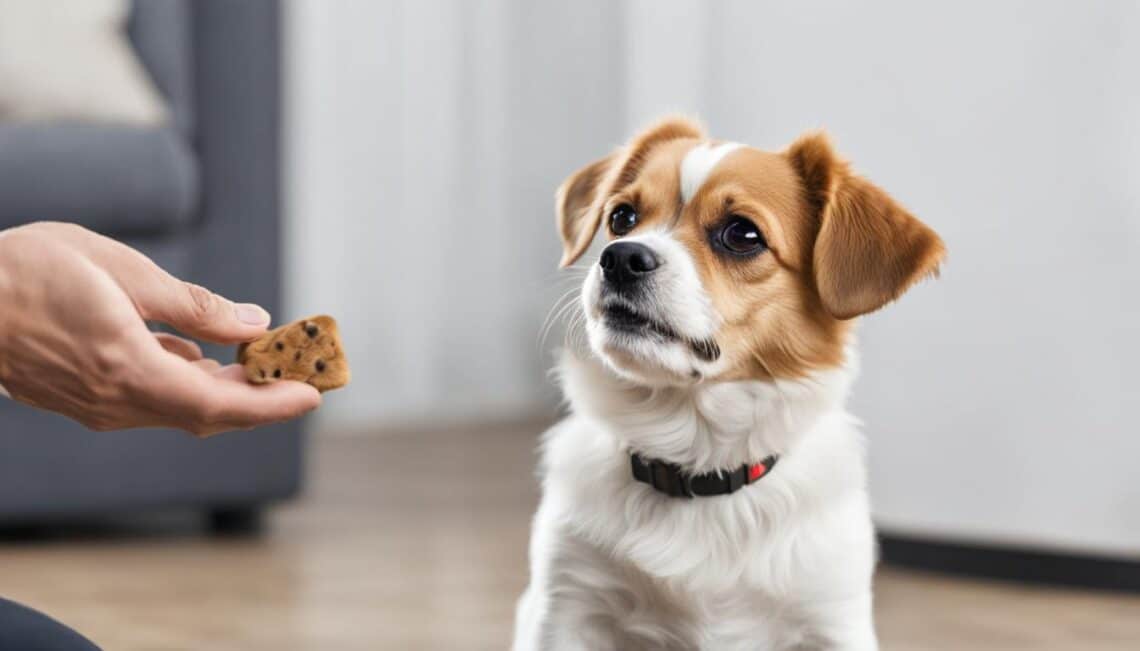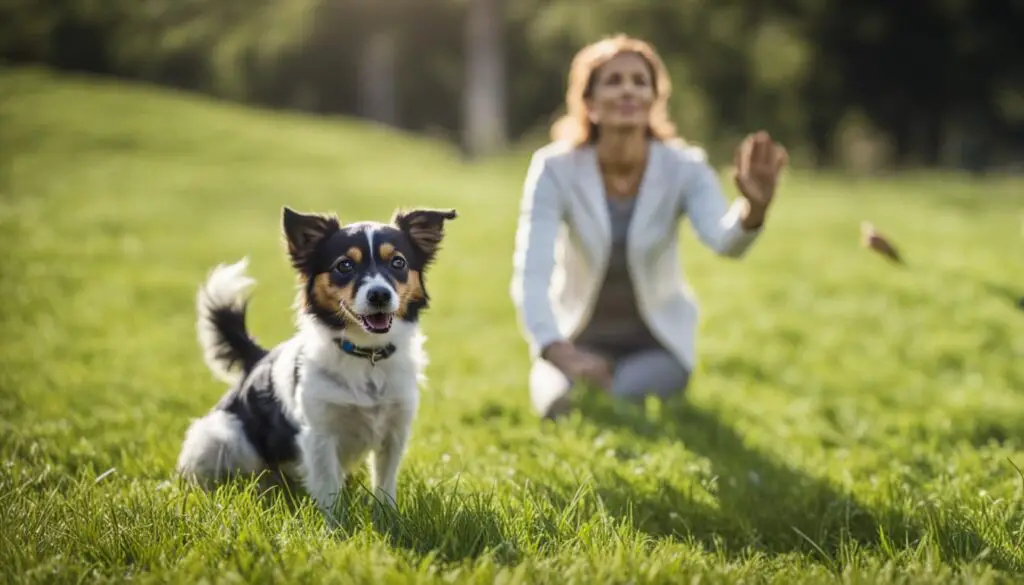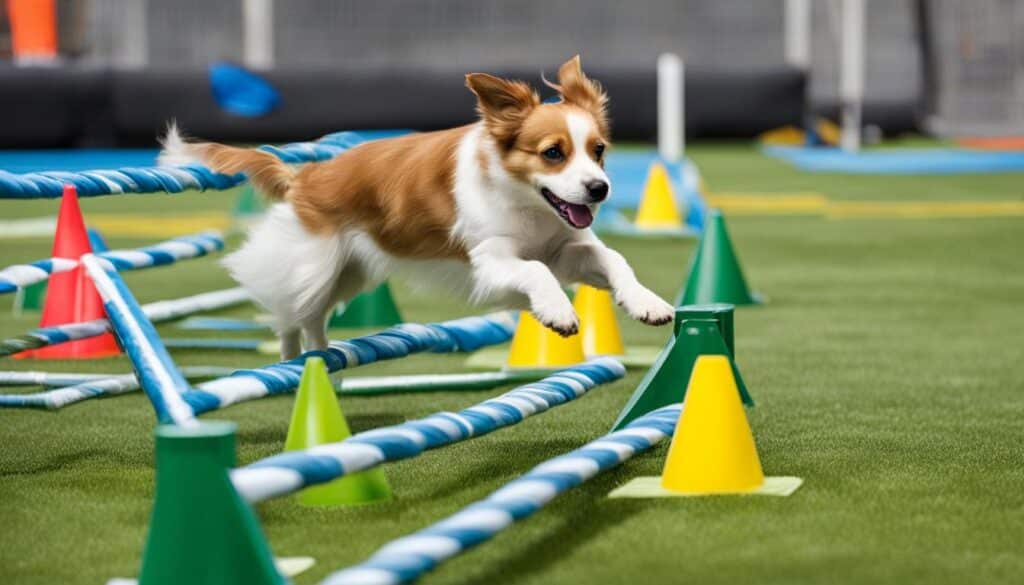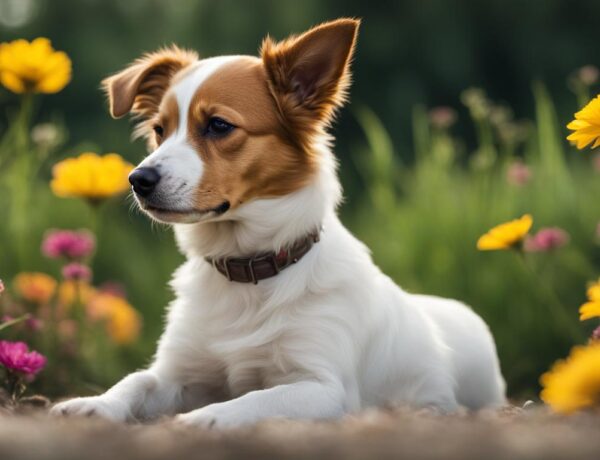Teaching commands to small dogs is essential for their well-being and obedience. As a small dog owner, it is important to understand and implement these basic training commands to ensure your mini companion is well-behaved and safe in various situations. By using positive reinforcement and consistency, you can effectively teach your small dog essential commands that will enhance their behavior and strengthen your bond.
Key Takeaways:
- Teaching commands to small dogs is crucial for their safety, well-being, and obedience.
- Basic training commands include “come,” “sit,” “stay,” and more.
- Positive reinforcement and consistency are the key to successful training.
- Training small dogs builds a stronger bond between owners and their furry companions.
- Well-trained small dogs are welcome in public places and can avoid potential dangers.
The Importance of Training Small Dogs
Training small dogs is crucial for their safety and the comfort of their owners. By teaching them basic commands, small dogs can learn to respond and behave appropriately in various situations. Training also helps build a strong bond between the owner and the dog, leading to a happier and healthier relationship. Well-behaved small dogs are more likely to be welcomed in public places and can avoid any potential dangers.
Training small dogs has numerous benefits, including:
- Improved safety: Training small dogs to respond to commands such as “sit,” “stay,” or “come” can prevent them from running into dangerous situations, like traffic or unfamiliar environments.
- Better socialization: Well-trained small dogs are more likely to interact positively with other pets and people, making it easier for them to navigate public spaces.
- Enhanced communication: Training fosters clear communication between the owner and their small dog, ensuring both parties understand each other’s expectations and needs.
- Reduction in behavioral issues: By teaching small dogs appropriate behaviors, such as not jumping on furniture or people, owners can prevent potential issues and create a more harmonious living environment.
- Increased mental stimulation: Training engages small dogs’ minds, providing them with mental exercise that can help prevent boredom and destructive behaviors.
When training small dogs, it’s important to use positive reinforcement techniques, such as treats, praise, and rewards. Stay consistent and patient throughout the process, as small dogs may require more repetition and encouragement compared to larger breeds. Remember that training is an ongoing process, and continuing to reinforce commands and practice regularly is essential in maintaining their skills and behavior.
“Training small dogs is not just about obedience; it’s about creating a strong bond and fostering a healthy relationship. By investing time and effort into training, owners can ensure their small dogs are well-behaved, confident, and happy companions.”
Teaching the “Come” Command
Teaching your small dog the “come” command is vital for their safety, especially when they are off-leash. To train this command, start by getting your dog’s attention with a treat or toy. Use a firm, but friendly, voice to give the command “come” while your dog is looking at you. Praise them and give them a treat when they start coming towards you. Practice this command regularly to ensure your small dog responds reliably, even when they are not on a leash.
Training Tips for the “Come” Command
Here are some additional tips to help you effectively train your small dog to come when called:
- Start training in a familiar and distraction-free environment to increase your dog’s focus.
- Use positive reinforcement, such as treats, praise, and petting, to reward your dog for coming to you.
- Practice the command with increasing levels of distractions, gradually introducing new environments and situations.
- Use a long lead or leash initially to ensure your dog’s safety while training the recall command.
- Avoid scolding or punishing your dog if they don’t come immediately. Instead, remain patient and reinforce the command positively.
Common Challenges and Solutions
While teaching the “come” command, you may encounter some challenges. Here are a few common ones and possible solutions:
| Challenge | Solution |
|---|---|
| Your dog gets distracted and doesn’t come | Practice in a controlled environment and gradually introduce distractions. Use high-value treats to enhance their motivation. |
| Your dog runs away or avoids coming | Reinforce the recall command with more consistent and positive rewards. Ensure your dog’s safety while training by using a secure area or long leash. |
| Your dog has had negative experiences with the recall command | Rebuild your dog’s trust by associating the command with positive experiences and rewards. Start with short distances and gradually increase the difficulty. |
Remember, consistent practice and positive reinforcement are key to successfully training your small dog to come when called. With patience and dedication, your furry friend will become reliable in responding to the recall command, ensuring their safety and your peace of mind.
Teaching the “Sit” and “Stay” Commands
When it comes to small dog obedience training, two essential commands that every owner should focus on are “sit” and “stay.” These commands not only promote good behavior but also ensure the safety and control of your furry friend. Here’s how you can teach your small dog these important commands:
Teaching the “Sit” Command
The “sit” command is crucial to prevent small dogs from jumping on people and maintain impulse control. Here’s a step-by-step guide to teaching your small dog to sit:
- Get your dog’s attention by using a treat or toy that they find enticing.
- Hold the treat or toy above their nose and slowly move it towards their head, causing them to raise their chin.
- As they naturally move to raise their head, their hind end should lower towards the ground.
- As their hind end touches the ground, say the command “sit” in a clear and firm voice.
- Immediately reward them with the treat or toy and praise them for their good behavior.
By consistently practicing this command, your small dog will learn to associate the “sit” command with the desired behavior and respond promptly.
Teaching the “Stay” Command
The “stay” command is crucial for keeping your small dog safe in various situations, such as when crossing roads or opening doors. Here’s how you can teach your small dog to stay:
- Start by having your dog sit or lie down.
- Once they are in a stable position, take a step back while maintaining eye contact.
- As you step back, say the word “stay” in a calm and steady tone.
- If your small dog remains in place without moving, return to them, reward them, and offer praise for obeying the command.
- If they attempt to move, gently guide them back to the original position and try again.
Continuously practice the “stay” command by gradually increasing the distance and duration to ensure consistency and reliability.
| Command | Description |
|---|---|
| Sit | Teaches your small dog impulse control and prevents jumping on people. |
| Stay | Keeps your small dog in place, ensuring their safety in various situations. |
Teaching Other Essential Commands
In addition to the basic commands, there are several other essential commands that small dogs can learn. These commands not only enhance their obedience but also improve their overall behavior and well-being. By teaching advanced training commands to your small dog, you can have better control over their actions and create a harmonious environment.
Advanced Training Commands for Small Dogs
Here is a list of some advanced commands that you can teach your small dog:
- “Down” command: This command teaches your dog to lie down and relax.
- “Potty” command: A useful command that helps in house-training your small dog.
- “Ring the bell” command: This command can be used to let you know when your dog needs to go outside.
- “Play” command: Teach your dog to engage in playtime activities with you on command.
- “Lay down” command: Similar to the “down” command, this command instructs your dog to lie down and remain in that position.
- “Quiet” command: Teach your small dog to stop barking on command, promoting peace and quiet.
- “Let go” command: Teach your dog to release objects that they have picked up, preventing potential hazards.
- “Find” command: Train your small dog to find objects or people based on scent or visual cues.
Each of these commands serves a specific purpose and can be taught using positive reinforcement techniques. Remember to be patient and consistent during the training process. Use rewards such as treats or praise to encourage your dog’s progress and reinforce their understanding of the commands.
By consistently practicing these advanced commands, your small dog can become a well-rounded and obedient companion. These commands not only impress others with your dog’s abilities but also enhance their safety and your peace of mind. Make sure to focus on one command at a time and gradually progress to more complex commands as your dog becomes proficient.
Tools for Small Dog Training
When it comes to training small dogs, having the right tools can make all the difference. Here are some essential tools that can aid in the training process:
1. Clicker Training
Clicker training is a popular method used in small dog training. It involves using a sound marker, such as a clicker, to inform the dog of the desired behavior. This positive reinforcement technique is followed by a reward, usually in the form of treats or praise. The clicker acts as a clear signal to the dog that they have performed the correct action.
2. Treats
Treats are an essential tool for training small dogs. They provide a positive incentive for learning and can help motivate your furry friend. Using high-value treats, such as small soft treats or even small pieces of cooked chicken or cheese, can make the training process more enjoyable and rewarding for your dog.
3. Toys
Toys can also be useful tools for small dog training. Interactive toys, such as puzzle toys or treat-dispensing toys, can help keep your dog engaged and mentally stimulated during training sessions. They can be used as rewards or as distractions to redirect your dog’s attention.
4. Leashes
A leash is an essential tool for small dog training, especially when it comes to teaching commands like “heel” or “come.” A lightweight and adjustable leash can provide you with better control and ensure the safety of your dog during training exercises and outdoor walks.
5. Training Aids
There are various training aids available that can assist in small dog training. Bells can be used to train your dog to ring them when they need to go outside for potty breaks. Target sticks can help teach your dog to touch specific objects or perform certain actions. These aids can enhance the training experience and make it more efficient.
Using the right tools for small dog training can significantly improve the effectiveness and efficiency of your training sessions. Whether it’s clicker training, treats, toys, leashes, or training aids, each tool plays a vital role in shaping your small dog’s behavior and creating a positive learning environment.
Conclusion
Training commands are crucial for small dogs to ensure their safety, obedience, and overall well-being. By teaching essential commands like “come,” “sit,” “stay,” and others, small dog owners can have better control over their pets and enjoy a harmonious relationship.
Training should be done using positive reinforcement techniques and consistency. With patience and practice, small dogs can become well-behaved and obedient companions. It is important to remember that training is an ongoing process, and small dog owners should continue to reinforce commands and practice regularly to maintain their skills and behavior.
By investing time and effort into training, small dog owners can create a strong bond with their furry friends and ensure their furry companions are well-behaved in various situations. So, start training your small dog today, and enjoy the benefits of a well-trained and obedient pet!
FAQ
What are some basic training commands every small dog owner should know?
Every small dog owner should know commands like “come,” “sit,” “stay,” “down,” “potty,” “ring the bell,” “play,” “lay down,” “quiet,” “let go,” “find,” and more.
Why is training small dogs important?
Training small dogs is important for their safety and the comfort of their owners. It helps them respond and behave appropriately in various situations, builds a strong bond between the owner and the dog, and ensures they are well-behaved and welcomed in public places.
How can I teach my small dog the “come” command?
To teach the “come” command, get your dog’s attention with a treat or toy, use a firm voice, say “come,” and praise them when they start coming towards you. Practice regularly to ensure a reliable response.
How can I teach my small dog the “sit” and “stay” commands?
To teach the “sit” command, get your dog’s attention with a treat or toy, gently push down on their hind end while saying “sit,” and reward them when they comply. For the “stay” command, have your dog sit or lie down, gradually step back while saying “stay,” and reward them if they stay put.
What are some other essential commands for small dogs?
Other essential commands for small dogs include “down,” “potty,” “ring the bell,” “play,” “lay down,” “quiet,” “let go,” “find,” and more, each serving a specific purpose and can be taught using positive reinforcement.
What tools can aid in training small dogs?
Tools like clicker training, treats, toys, leashes, and training aids like bells or target sticks can aid in training small dogs.







No Comments